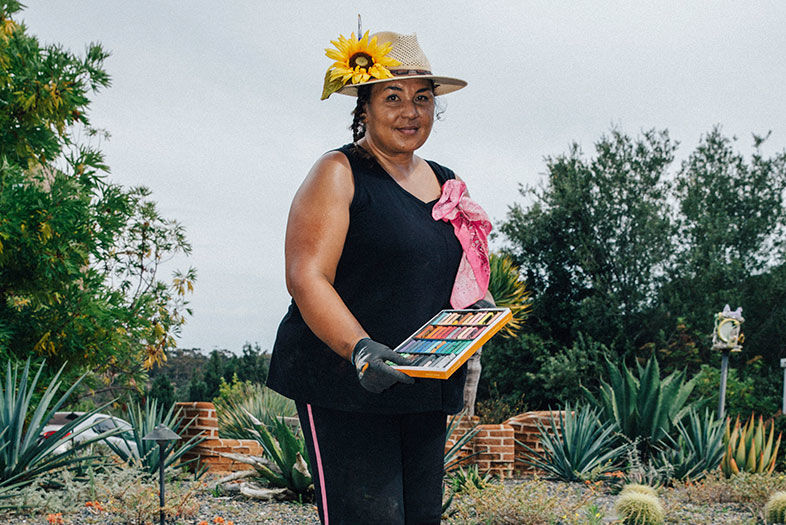10:39 a.m.
“This is the part people don’t see—the prep.” Linayao begins by taping off her 6-by-8-foot area, then rolls on a layer of tempera (an impermanent, water-soluble paint) to create a surface her chalk sticks to. She uses a snap line to grid her canvas and outlines her painting standing up, with a piece of chalk taped to a yardstick. “This way I can see what I’m drawing.”
11:20 a.m.
Every street art piece begins on Linayao’s computer. She creates a rendering and prints it out to reference as she works. Today, Michelangelo’s David is the basis of her collage, with art symbols jutting from it: Balboa Theatre, a painter’s palette, a film reel, and a guitar. “It’s a contrast between the classic and contemporary.”
Sun Stoppers
“Staying hydrated is no joke. I’ve seen artists sent to the hospital.” To beat the heat, Linayao drinks lots of ice water, uses SPF 30 or higher, and dons her bandana (to wipe her sweat) and Stetson hat. “I experimented with sun hats over the years, but I needed a working hat, not a vacation hat.”
“When my energy is high, I’ll do the hardest thing first. This face is the most important, so I want to make sure that gets my energy,” Linayao says. “Hands and faces, they’re the most difficult things to draw and paint. I can’t resist. Part of that is because once you get it right, it’s amazing.”
12:28 p.m.
“Using gloves is like drawing with a baseball mitt. The first times I did street painting, I wouldn’t use them. Then, I rubbed off all of my fingertips—they started to bleed!” Now, she doubles up on days like today, when the surface is extra rough, and will replace them three or four times.
1:44 p.m.
“I’m painting on rocks today, literally. That’s what a lot of artists have a problem with—working with the elements and not in a studio. It won’t be slick or glamorous. Street artists should be realists.”
3:12 p.m.
“I’m sitting on the cardboard, because it doesn’t disrupt the chalk. You can’t use rubber or plastic.” She stands every 45 minutes to look at her progress. “It’s really a physical art form. That’s why I started doing yoga, so I’m stretched out. I now have some moves that are really good for sitting on the ground.”
Choosing Chalk
Linayao is going through about 100 pieces of chalk today. She uses only soft pastels, never oils, because they’re temporary but pigmented enough to stick for a long while. Most importantly, they’re biodegradable and nontoxic, making them easy to wash away responsibly.
3:44 p.m.
“People say it’s a waste of time because it washes away. I counter that with this: You have downloads of your favorite music, yet you still go hear it in person. It’s the same with this—an experience to witness live and interact with the artist. Because this is a temporary art form, I have to do the best I absolutely can here and now. When it’s done, I have to let go, reflect, and savor the moment. If I don’t, that beautiful process will have gone.”
Meet the Artist
“There are so many ways to be an artist,” says Cecelia Linayao, who’s versed in everything from painting to origami (and teaches them). That’s on top of commissioned gigs and business travel to street art festivals. She began working in chalk 15 years ago and has since been the featured artist at large-scale fests and worked with a team that holds the world record for the largest chalk drawing. “I want to paint once in every country. With art being a universal language, that should be no problem, and I’ll be an artist forever. I’ll hold a paintbrush with my teeth!”
See Cecelia Linayao!
September 21–22
Armada Drive, Carlsbad
PARTNER CONTENT


















